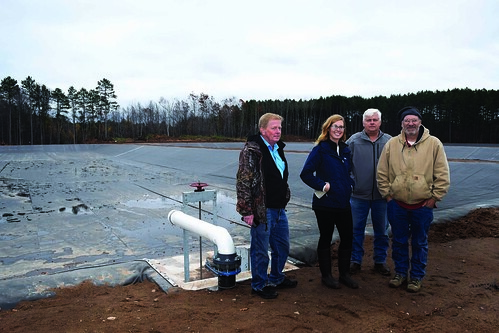
“The Tribe wants to provide a sustainable supply of walleye for tribal and non-tribal fishing in reservation waters,” said Lac du Flambeau Tribe Natural Resources Director Larry Wawronowicz. “Raising the fish larger is necessary now due to shoreline development, increased competition from in aquatic invasives like zebra mussels, and climate change.”
Sustainable conservation and protection of natural resources has always been a goal of the Lac du Flambeau Tribe since inhabiting parts of Wisconsin in 1745. The Tribe acquired the name from its gathering practices of harvesting fish by torchlight at night. Their focus is to protect pristine areas, restore degraded natural and wildlife resources, and help build strong communities.
The reservation, established by the Treaty of La Pointe in 1854, includes 86,000 acres of land, 24,000 acres of wetlands, 260 lakes and 65 miles of streams and rivers.
From its small beginnings with a fish hatchery in 1936 to today, Lac du Flambeau now has grown into a multi-faceted Tribal natural resources department raising and restocking fish to meet their vision of sustainability. Over the last 30 years, the hatchery has restocked the lakes with well over 415 million walleye.
Common missions and participation in the Wisconsin Tribal Conservation Advisory Council, an advisory group consisting of the 11 federally recognized tribes in Wisconsin, have fostered a strong conservation partnership with USDA’s Natural Resources Conservation Service (NRCS) and the Tribe. Multiple technical and financial assistance projects to combat shoreline erosion, improve wildlife habitat, improve forest health, improve wild rice populations and build hoop houses, were made possible through NRCS’ Environmental Quality Incentives Program (EQIP) and the Conservation Stewardship Program (CSP).
“We’ve addressed resource concerns on more than 11,000 acres of tribal land, through EQIP, since 2009, and we recently re-enrolled more than 28,000 acres of forestland in CSP,” said NRCS District Conservationist Michael Stinebrink.
The most-recent project partnership between the Tribe and NRCS includes the renovation of five aquaculture ponds through EQIP.
After 30 years, the original fish pond liners had fallen into disrepair and the harvest of fish was labor intensive. Since reconstruction, the facility has gone from 13 small ponds, having about five acres of usable rearing space, to six large ponds with more than seven acres of surface area. Two newly-constructed, centrally-located, fish gathering structures―known as kettles―save the hatchery’s staff the labor of harvesting each pond individually and reduce stress and mortality on the fish during harvest. NRCS provided technical and financial assistance to redesign the ponds and implement the renovations, including a new network of water supply and aeration lines and a sediment tank for treating the water before entering an adjacent wetland.
“Before the reconstruction, the Tribe was rearing two-to-four inch fingerlings in the small ponds, and now they can raise six-to-eight inch fish for better survivability in the wild,” said Tom Melnarik, soil conservation technician, and designer of the new aquaculture pond site layout.
In spring, fish spawn and tribal spawning crews collect and fertilize eggs. Most fish are hatched by early June when the aquaculture ponds are stocked with the walleye fry. The young fish feed on zooplankton until approximately six-to-eight weeks old. Their diet then changes to aquatic insects and other fish species. Fish are raised from the size of a mosquito in spring to six-to-eight inches in fall and are then released into reservation waters.
The new aquaculture ponds will help the Tribe to restock more than 200,000 fish per year in area lakes and other waterways. “We wouldn’t have been able to get this project done without the technical support, financial assistance, and partnership of the USDA−NRCS,” said Wawronowicz.
NOTE: For an interactive look at USDA's work in conservation and forestry over the course of this Administration, visit http://medium.com/usda-results.

